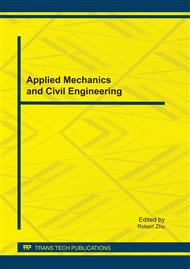p.403
p.408
p.414
p.419
p.424
p.429
p.435
p.440
p.445
Research on Vortex-Induced Vibration Behavior of Steel Arch Bridge Hanger
Abstract:
A fluid-structure interaction numerical simulation technique based on CFD has been developed to study the vortex-induced vibration behavior of steel arch bridge hanger. Above all, wind acting on bridge hanger is simulated by using Flunet and then vortex-induced dynamic motion of hanger is solved by method in the User Defined Function (UDF). Finally hanger’s transient vibration in wind is achieved by dynamic mesh method provided by Fluent. Using this technique, the vortex-induced vibration behavior of hanger of the Nanjing Dashengguan Yangtze River Bridge is analyzed, including vibration amplitude, vibration-started wind speed and vortex shedding frequency. The study also considers influences of different section type (rectangle, chamfered rectangle and H) of hanger. The following conclusions are obtained. Firstly hanger of different section has different vibration behavior. Secondly vibration-started wind speed of different section hanger differs with each other. Thirdly relation between vibration amplitude and incoming wind speed varies obviously. At the same time, numerical results are compared with those of one wind tunnel test and the out coming is satisfied. Relation between vibration amplitude and wind speed in both numerical simulation and wind tunnel test is similar because vibration-started wind speed in numerical result has only 10% discrepancy with that in wind tunnel test while vibration amplitude’s discrepancy is only 15%. Consequently, analysis results show the reliability of this numerical simulation technique.
Info:
Periodical:
Pages:
429-434
Citation:
Online since:
October 2011
Price:
Сopyright:
© 2012 Trans Tech Publications Ltd. All Rights Reserved
Share:
Citation:


